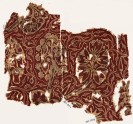Newberry Collection
Explore Percy and Essie Newberry's important collection of textiles including Islamic embroideries and Indian block-printed fragments.

Just over half of the Newberry textile collection at the Ashmolean is made up of Indian cotton fabrics traded to Egypt. There are 1226 items, most of them fragmentary, but with the original design and colour still clearly visible.
Textiles in trade
In medieval times, cotton fabrics were a major export from India to all parts of the Indian Ocean – they were in demand from East Africa to Indonesia. Historical documents from Egypt and southern Arabia refer to the significance of this trade, and the Newberry textiles provide important primary evidence. As radiocarbon analysis of key pieces has shown, most of the collection dates from the 10th to the 15th century.
Textile printing
The majority of textiles in the collection were block-printed with resist (to prevent chosen areas of the fabric from being dyed) or mordant (to fix the dye more firmly to the textile fibres), or a combination of both. However, there are also some fragments that were drawn by hand. The fragments can be grouped by colour into three sub-sections – blue and white, red and white (with one or more tones of red), and red, blue, and white. The dyes used were indigo for blue, and madder or Morinda citrifolia for red. By manipulating mordants, many variations of red could be achieved. The quality of dye used was remarkable, as much of it remains vivid to this day, even where much of the fabric has disintegrated. The patterns preserved are mostly vegetal and geometric, with some figural examples, showing both humans and animals.
 Textile fragment with interlocking medallions (EA1990.320)
Textile fragment with interlocking medallions (EA1990.320)
 Textile fragment with flowering trees (EA1990.823.a)
Textile fragment with flowering trees (EA1990.823.a)
 Textile fragment with flowering trees (EA1990.823.b)
Textile fragment with flowering trees (EA1990.823.b)
 Textile fragment with two warriors (EA1990.1010)
Textile fragment with two warriors (EA1990.1010)
 Textile fragment with stylized trees and bunches of fruit (EA1990.1129)
Textile fragment with stylized trees and bunches of fruit (EA1990.1129)
Use of printed cottons
These cotton fabrics were used for garments and furnishings – some of them still retain hems and tabs, as well as seams. The fact that most of the threads used for these seams are of flax – a fibre commonly used in Egypt, but not in the Indian subcontinent – suggests that these fabrics were imported as uncut cloth, and fashioned into clothing and house furnishings once in Egypt. They were imported as common, utilitarian fabrics, rather than luxury items.
© 2013 University of Oxford - Ashmolean Museum
